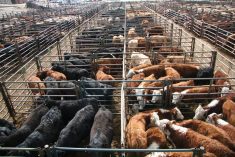LETHBRIDGE, Alta. — More manure is not better, says a team of researchers who made a presentation recently to the Agronomy 2001 conference in Lethbridge.
Chi Chang, who works at Agriculture Canada’s research centre in Lethbridge, said manure is a good soil amendment and fertilizer, but it is not perfect.
“There is a little problem with manure. It is an unbalanced fertilizer.”
Added University of Saskatchewan soil scientist Jeff Schoenau: “You’ve really got to know what is in that stuff in order to manage it properly.”
Read Also

Canada told trade crisis solutions in its hands
Canadians and Canadian exporters need to accept that the old rules of trade are over, and open access to the U.S. market may also be over, says the chief financial correspondent for CTV News.
Barry Olson of Alberta Agriculture said recommended spreading rates in terms of volume per acre are not as important as knowing the actual chemical content of the manure. This is followed up with a detailed soil analysis to prevent overapplication and potential damage to plants.
Overloading the soil with manure increases electrical conductivity, which indicates a salt buildup.
Another problem is the inconsistency of manure content, which can depend on climatic conditions, animal species, storage systems, feed rations, moisture content and types of bedding material.
Manure is an organic fertilizer but plants can only use inorganic nutrients. Transformation from one to the other takes time, which means only a portion of nutrients are available to the plant during the first year of application.
Solid manure takes longer to release nutrients than liquid manure.
One problem with nitrogen is that it can be converted to gas and lost to the atmosphere. It can also leach through the soil beyond the root zone so it is no longer useful to plants.
Studies have found that injecting liquid manure or working solid manure into the soil as soon as possible are the best ways to prevent some of these problems.
Phosphorus overload is another concern.
At least 40 to 50 percent of phosphorus becomes available during the first year and nearly all is available after three years.
However, if too much is applied, especially on irrigated land, the phosphorus runs off through soil erosion or leaching.

















